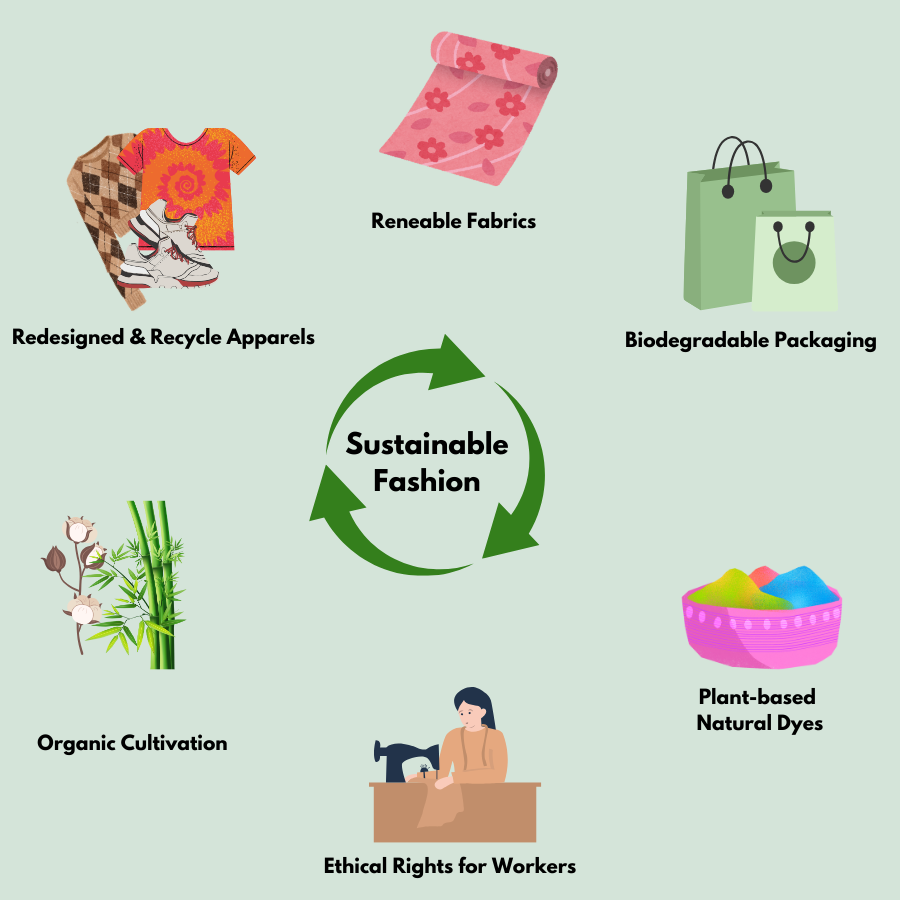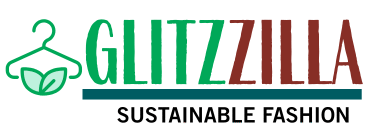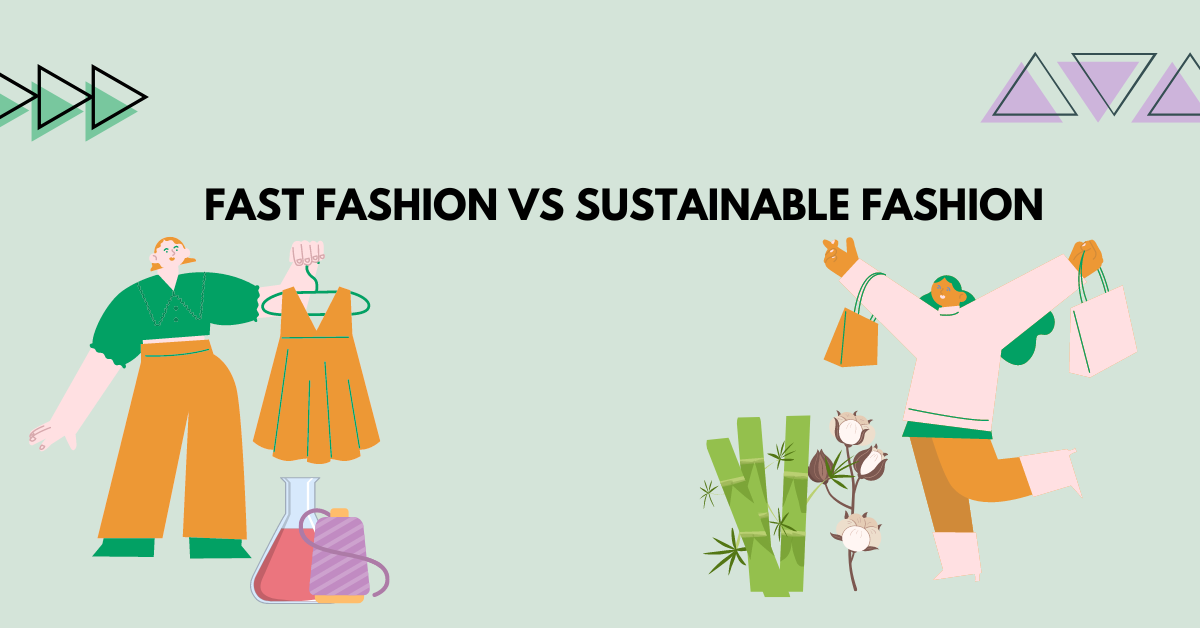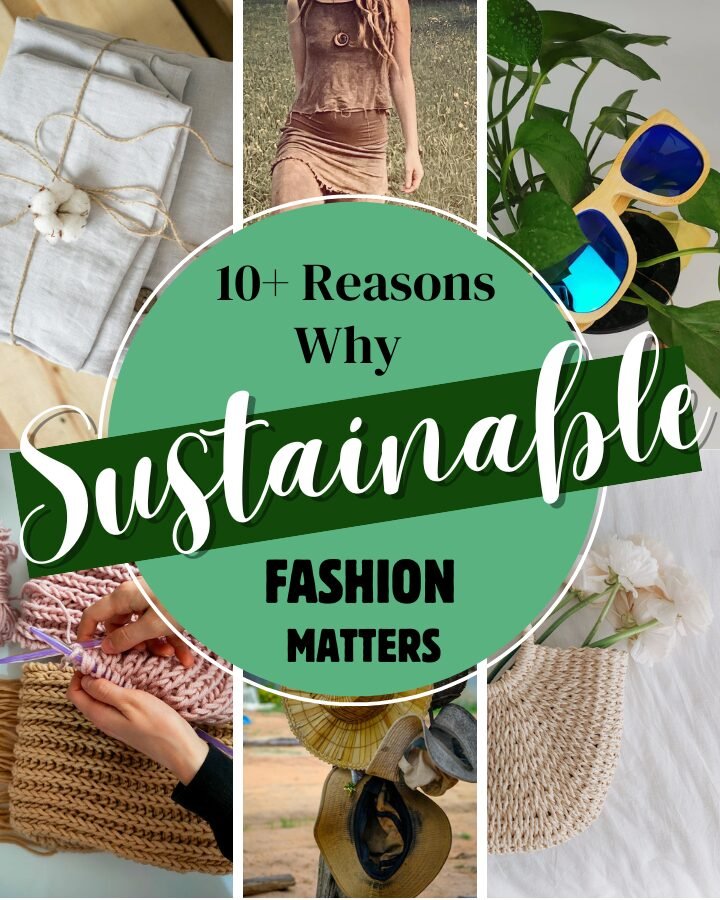Fast Fashion Vs Sustainable Fashion: An Ultimate Guide
Celebrity culture and fashion week events have made fashion an inevitable part of our lives, even fueled by social media trends.
However, trendy and cheap apparel items, better known as fast fashion, always clash with durability and products made of organic materials, making sustainable fashion brands popular these days.
Consumers find it difficult to make wise choices without knowing the difference between fast fashion and sustainable fashion. If you feel the same way, this article can be a true fashion guide!
What is Fast Fashion with its Background?
Fast fashion includes mass-producing business models at a low cost and making the products available for retail when demand is high.
Mainly, it refers to products, including clothing and footwear, and follows the catwalk trends and high-fashion designs.
Fast fashion dates back to the late 20th century when it emerged as a business when apparel manufacturing was less expensive.
Though it started in the 1970s, when Western countries exported textile productions from Asian countries, fast fashion took hold in the 1990s.
At that time, South, Southeast, and East Asia were ahead of other parts of the world in clothing manufacturing, depending on low-cost women’s labor.
Before 2000, people could still differentiate between luxury and street fashion. But with the beginning of the 21st century, clothing consumption increased rampantly, and fast fashion became inevitable.
Today, giant retailers in the fast fashion industry are Primark, H&M, Forever 21, Shein, and Zara.

In other words, fast fashion also describes cheap, low-quality clothing that is often replicas or responses to popular styles of fashion labels, trends, popular culture, giant brands, and several independent designers.
In this regard, the fashion industry makes a huge chunk of profit from fast fashion and people can afford more clothes in this glamorous world.
Key Features of Fast Fashion
It becomes difficult for anyone, including you, to spot fast-fashion products due to their higher price tags, unethical sources of fabrics, and rampant infiltration into the market.
However, the following characteristics make the fast fashion stand identified even from a far distance.
Rapid Production Cycles: While new clothing collections were consumed four times earlier, people with fast fashion expect more collections, reaching up to 36 in number. It is even surprising that mass production has already surpassed 100 billion garment production per year, according to a report a decade ago.
High Consumer Demand: This kind of fashion lives on the consumers’ desire for constant newness, fueling more production. Besides, it throws numerous collections throughout the year based on weekly, monthly, or seasonal installments, with each event having a separate wearable.
Trend-Driven: Nothing but new runway trends always reign in fast fashion. You can notice it copying high-end designer looks only to feed the consumers with the latest or up-to-date and stylish apparel. Whether it’s celebrated by celebrities or simply popped out from a recent social event, fashion has become trendy. For instance, oversized blazers, graphic tees, and high-waisted jeans all indicate transitory fashion.
Cheap Materials: You cannot expect good quality materials when companies produce tons of clothes every day. Fast fashion often uses synthetic fibers, including polyester, nylon, and acrylic, making the clothing non-biodegradable. This also encourages consumers to adopt a disposable clothing culture rather than invest in durable and long-lasting wearables.
Low Costs: Affordability wins, after all. However, that, too, invites the end of premium and luxury consumption. Besides, low-quality materials based on the cost and short lifespan of clothes only promote a short wear-and-throw culture.
Influence of Social Media: In this social media world, fast fashion has leveraged the marketing of its products through influencers. Platforms, including Instagram, Facebook, and YouTube, have become hubs to create buzz around the latest trends and promote trendy styles. Though it seems producers have tagged some names on items, they, in fact, avoid branding their products. Even if they do, they do it at a minimal level.
Pros & Cons of Fast Fashion
Today, fast fashion products get easy trends worldwide and have no match in popularity, but will these be enough? Here are some good and bad aspects of fast fashion that help consumers make the right decisions while dealing with it.
Pros of Fast Fashion
Affordable Pricing: You can buy floral print jumpers for $2.99, kids’ T-shirts for $4.26, or tank tops for $4.88. The average dress price on Shein was $15.74, while Zara priced $48.19 in 2024 in the US. Besides, an average of outwear products were sold at $19.72, while H&M and Zara charged $51.22 and $78.27, respectively.
Quick Access to Trends: Thanks to fast fashion’s frequent releases at affordable prices, consumers have easy access to trendy clothes and wearables. In 2024, Bows, Low-rise Jeans, Adidas Campus’ and Sambas, Cheetah Print, and Camo Print will be the available fashion trends, so people can have numerous options for every occasion.
Economic Growth: Fast fashion became a $136.19 billion industry in 2024, growing by 10.74% from 2023, and is estimated to reach $291.1 billion by 2032. Clothing production has increased multiple times in the last 15 years due to the rise of middle-class families and per capita income.

Convenience: Those passionate about fashion prefer fast fashion to update their wardrobes. They can get new, trendy clothes with minimal effort by buying them online or at malls. People do not need to worry about durability as they can get new ones frequently for the price of taking care of old clothes. They can easily copy styles or designs from their favorite celebrities.
Global Availability: Cheap clothes do not require a big investment, so you can get them at your local mall wherever you are. Unlike wearables made of particular or natural materials and high-quality designs, fast fashion is often backed by cheap and low-quality materials, contributing to worldwide consumption.
Cons of Fast Fashion
Environmental Impact: On average, people with high per capita income create 76% more clothing waste than those with less income. The Fashion industry generates 10% more carbon than emissions from international air flights and maritime shipping combined. Only the United States generates 15.8 megatons of textile waste annually, with a 2.5 megatons recycling capacity. Globally, 1% of old clothes are recycled today.
According to an IUCN report, 35% of all microplastics in the ocean come from the materials used in fast fashion products.
Low Quality: If you notice while laundering your cheap clothes, you can find little or more fibers coming out from polyester and acrylic. In fact, 70% of all garment materials are synthetic fibers that include elastane, nylon, and acrylic. In fast fashion clothes, polyester alone contributes 52% of all the fibers to produce clothes.
Exploitation of Labor: According to the US Department of Labor, 80% of contractors employed workers at minimum wage and overtime pay in 2023. Can you believe that even people were working at garment companies for $1.58 per hour, whereas the minimum wage by law was $15 per hour? If this condition is in developed countries like the US, let alone the Asian countries such as China, Bangladesh, India, and Vietnam, where employees are women.
Promotes Overconsumption: Today, people wear clothes an average of 7 to 10 times only before throwing them away. It has cut down by 35% in the last 15 years. In this context, women shop for clothes twice as much as men. About 41% of young women (18-24 years old) feel pressured not to wear the same clothes more than twice.
Unsustainable Practices: Fast fashion companies have consumed natural resources unethically for their rapid and mass production. It is responsible for excessive water use, particularly in cotton production, releasing harmful chemicals and dyes, and deforestation to process fabric materials like synthetic fibers and rayon.
Attention! Synthetic fiber production uses 1.35% of the global oil supply, which is more than Spain’s annual oil consumption.
Lack of Originality: Whenever you buy cheap and low-quality wearables, most of them result from copying the original brands. Replicating high-end designer looks, fast fashion focuses on mass production rather than innovation.
Sustainable Fashion with History
Sustainable Fashion is an industrial approach that primarily uses natural or organic materials and intends to have minimal impact on the environment.
It is often associated with “slow fashion,” “ethical fashion,” and “organic fashion,” which have extended concepts and approaches.
Besides, sustainable fashion has been a global campaign to promote environmental and social responsibility in apparel production and consumption.

The 1960s and 1970s were the decades that laid the foundation of sustainable fashion through environmental awareness.
This led to creating vital organizations including Greenpeace and Friends of the Earth, which promote sustainability and run campaigns to protect the earth.
Thanks to Hippies and Punks, who embraced this idea and introduced sustainable fashion for the first time. Besides, Hippies preferred natural fabrics, while Punks started re-wearing, upcycling clothes, and promoting second-hand and vintage clothing.
When fast fashion, with its cheap and trendy features, was introduced in the 1990s, the concept of slow fashion emerged to control overconsumption and reconsider the quality of apparel items.
Besides, climate change and environmental concerns encouraged a few brands to consider sustainability as a marketing strategy, which invited organic fashion.
Though clothes made of synthetic fibers were in high demand, people also started preferring cotton and environment-friendly fibers.
Finally, sustainable fashion was born in the 2000s when pioneer brands like Patagonia and People Tree started producing recycled clothes, and stylists, including Stella McCartney, focused on fashion that was both stylish and eco-friendly.
Then, the 2010s saw the continuous growth of sustainable fashion, as numerous stakeholders, such as fashion brands, NGOs, and consumers, participated in promoting sustainable practices.
However, it was also a time when over a thousand people lost their lives in a garment factory in Bangladesh in 2013. This exposed the real face of fast fashion and demanded transparency and ethical practices in the fashion industry, thus, ethical fashion.
Seeing such events, the US, which produced 95% of garment items in the 60s, cut down to only manufacturing 5% by 2015.
In recent years, sustainable fashion has also evolved using biodegradable fibers, leather alternatives, and new technologies, such as 3D printing.
Consumers, especially the younger generation, have responded to it with social responsibility. According to a 2021 fashion report, about 42% of Millennials and Gen Z were found buying secondhand clothes. Also, one-fifth of United Kingdom consumers prefer clothing from sustainable brands.
Key Features of Sustainable Fashion
If you’re planning to shop for sustainable fashion products, make sure the brands are certified with AS8000 and B Corp. Besides, the following characteristics will help you identify sustainable fashion more easily.
Use of Eco-friendly Materials: Sustainable fashion focuses on using organic, recycled, and biodegradable fabrics, including organic cotton, h*mp, recycled polyester, and Tencel, which have an environmental effect.
Minimal Waste Philosophy: The fashion approach embraces zero-waste design techniques and promotes the recycling of fabric scraps to reduce production waste.
Ethical Production: Unlike fast fashion, it ensures fair labor practices including safe workplace and fair or deserving wages for all workers involved in the garment production.
Lower Carbon Footprint: Ensuring a safe environment and sustainable fashion aims to reduce energy consumption and greenhouse gas emissions.
Non-toxic Dyes and Chemicals: Brands based on sustainability use natural or low-impact dyes to avoid chemicals that pollute water reservoirs and affect workers’ health.
Water Conservation: Fashion industry consumes 79 trillion liters of water every year so a sustainable approach uses water-efficient practices including reuse of dying liquid, cooling and washing water and farming through waste and rainwater.

Biodegradable Packaging: Have you ever noticed sustainable apparel items come with boxes of paper or other eco-friendly, recyclable, or biodegradable packaging materials to decrease plastic waste.
Quality over Quantity: This encourages generating fewer productions but long-lasting and high quality, causing no need for frequent purchases.
Support for Local Artisans: In addition to using organic and local materials, sustainable fashion promotes handcrafted goods made by local artisans, which helps sustain traditional skills and disappearing cultures.
Conscious Consumption: Well-informed consumers make responsible choices that contribute to a better Earth. Thoughtful buying habits help consumers invest in fewer yet higher-quality and sustainably made products.
Seasonless and Evergreen Fashion: You can wear and use sustainable fashion products anytime and anywhere with comfort and style. They are timeless, evergreen and versatile pieces that can be worn throughout the year.
Transparency and Traceability: Another responsible step is to raise awareness of the production process so that consumers can make informed choices. Sustainable fashion is doing the same by providing enough information about the complete supply chain, from the selection and use of raw materials to the final product.
Reduced Transportation Impact: Sustainable fashion products are made locally and for locals primarily, which minimizes transportation distances. However, this doesn’t mean overseas consumers cannot buy.
Promotes Animal Welfare: Though it promotes using natural and organic materials, sustainable fashion avoids products made from animal exploitation. Besides, it refrains from using animal skins, fur, and other body parts and fosters cruelty-free alternatives.
Sustainable Business Model: As the name suggests, it adopts circular, sharing, and resale models, helping establish the sustainable economy. This helps ensure clothing repair, reuse, and recycling to extend product life and reduce mass production and waste in landfills.
Pros & Cons of Sustainable Fashion
Though it feels soft and silky to touch, sustainable fashion apparel is costly compared to others, making it hard for all consumers to access. However, ethics and environment oriented purposes win all costs.
Pros of Sustainable Fashion
Sustainable Use of Natural Resources: Sustainable fashion advocates for responsible consumption of available natural resources and recycling those resources to save for future generations. Practices such as reducing water and energy use help to have less impact on the environment.
Social Responsibility: Brands based on sustainability raise campaigns for ethical production, ensuring controlled manufacture, workers’ safety, and responsibility for earth preservation. They contain GMO (Genetically Modified Organism) and Fair Trade certificates.
Healthy for Consumers: Over 8,000 types of chemicals are used in manufacturing clothes, and 43 million tons of chemicals are used in the fashion industry to dye and treat the clothes. So, eco-friendly clothes use organic and non-toxic materials, including natural, gentler dyes. This can protect you from skin irritation or exposure to harmful substances.
Sustainable Economy Growth: In addition to selling new items, sustainable fashion has also developed multiple sustainable business models. The “zero waste and cradle-to-cradle model,” “fashion rental and clothing swapping,” and “repair, recycle, and resale ” have contributed to sustainable growth.
Promotes Innovation: Thanks to sustainable fashion, several innovations have been derived, including the development of new materials, such as plant-based leathers and eco-friendly manufacturing techniques. Besides, 3D virtual sampling and virtual dressing for buyers and blockchain technology to track manufacture and supply are already in the sustainable fashion market.
Cons of Sustainable Fashion
Higher Cost: Due to ethical labor practices and quality materials, apparel items are often more expensive. However, everyone cannot afford $289 on a puffer hoodie and $378 on a cashmere sweater from environmentally friendly brands Patagonia and Eileen Fisher, respectively.
Limited Stocks: Eco-friendly clothes take an extended time to release in the market due to the long manufacturing process: farming, sourcing and processing raw materials, design, dyeing, and finally, the product. The lengthy process slows down production, making eco-friendly clothes limitedly available for consumers.
Niche Market: Sustainable fashion is still a niche market, with $8.1 billion globally in 2024, sixteen times smaller than fast fashion. Also, fewer people have access to limited sustainably made apparel.
Care Requirements: Unlike synthetic clothes, some sustainable fabrics need special care and treatment, including handwashing, air drying, or steaming the clothes instead of ironing. Also, some strict care instructions can be less convenient for consumers.

Limited Trends: Though sustainable fashion is timeless, it has only a few trends, including upcycling and recycling, eco-friendly fabrics, minimalist wardrobes, etc. These limited trends cannot cater to all types of consumers.
Complex Supply Chains: It is difficult to track all the manufacturing stages roughly ranging from raw materials to ready products, making true transparency hard to achieve. This gives several brands a loophole only to claim their products are eco-friendly.
Fast Fashion Vs Sustainable Fashion
While fast fashion allows cheap products and easy access to trendy apparel, you can only fulfill your wear needs and save the environment through sustainable fashion. Here is a summarized version of the difference between these two fashions.
[table id=1 /]
FAQs Related to Fast Fashion Vs Sustainable Fashion
1. What is the difference between fast fashion and sustainable fashion?
There are several differences between fast fashion vs sustainable Fashion regarding production procedures, environmental impact, consumer behavior, etc. In a nutshell, fast fashion generates massive environmental damage, mass production in a short time, and cheaper products. On the contrary, sustainable fashion helps save resources and produces eco-friendly but costly apparel items.
2. Why is fast fashion bad for the environment?
Though fast fashion products are cheap, they cost the healthy environment in the long run. It is the third biggest polluter in the world, emitting 10% carbon footprints and 15.8 megatons of textile waste, consuming 93 billion cubic meters of water and 1.35% of the world’s oil annually.
3. Is sustainable fashion more expensive?
Yes, sustainable fashion products are more expensive than fast fashion, as they follow ethical production guidelines, including Fairtrade, GMO, and GOTS. However, they are high-quality items that are good for consumers and the environment.
4. Can fast fashion brands become sustainable?
The problems with fast fashion include excess usage of resources, including water and energy, and dumping textile wastes in the fields and ocean, with less than 1 % recycling only to pollute the environment. It only survives only on frequent new trends and low prices. Though it has a big market size today, fast fashion won’t last long; once resources run out, workers revolt, and consumers change their buying habits.
5. How can I start supporting sustainable fashion?
Here are some actionable steps:
- Purchase fewer but higher-quality apparel items.
- Shopping only from ethical and eco-friendly brands.
- Opting for secondhand or vintage garments.
- Repairing or upcycling and sharing old clothing.
- Acknowledging brand transparency and sustainability efforts.
6. What are some affordable, sustainable fashion brands?
Some recommended brands are:
- Pact: Popular for garment clothes made of organic cotton
- Girlfriend Collective: Sustainable brand for size-inclusive athleisure wear
- ThredUp: Platform for women’s and kids’ apparel, shoes, and accessories
- Boody: Ethically crafted bamboo clothing place
- Sense Organics: Items made of organic cotton for babies and toddlers
We are dedicated to making our readers aware of sustainable fashion with everything that comes across, including trends, how-to guides, reviews, and wardrobe ideas.


